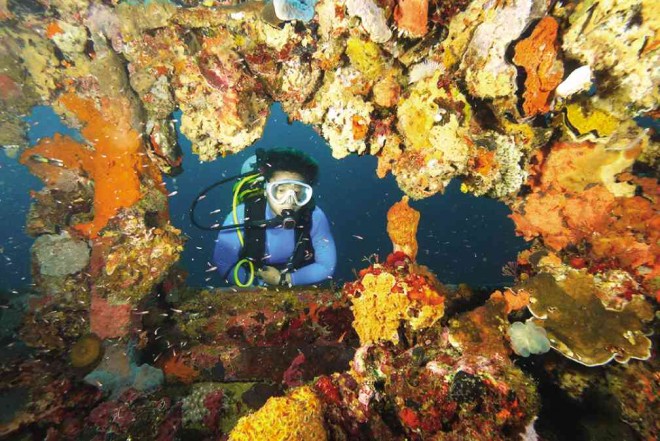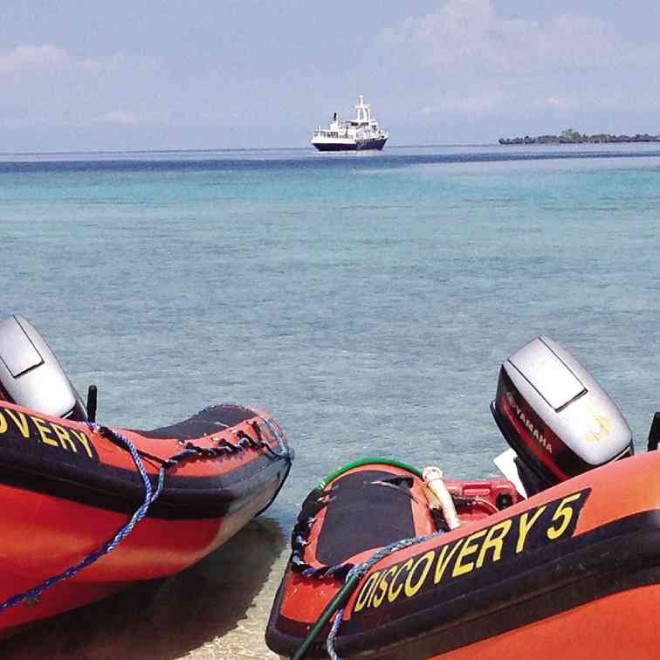
It was, in many ways, like coming home.
Every scuba-diver will tell you that gearing up is the most tedious part of the sport—donning several pounds of lead weights, a steel tank, regulators, a buoyancy compensator, a wetsuit that’s very hot and tight on land. And then, you hit the water—and you fall in love all over again.
It was like that when, after several months away from the sea, I backrolled into the ocean one sunny, unusually warm October morning in front of the Apo Mayor Ranger Station in Apo Reef, Sablayan, Mindoro.
I was among several divers led by divemaster Anne Astorga, and we were at the Apo Reef Natural Park, a 27,469-hectare natural marine park between Mindoro and Palawan province, home to the world’s second largest continuous coral reef, and the largest atoll in the Philippines.
We were on a cruise-cum-dive trip on board the M/Y Discovery Palawan of the Discovery Fleet. Cruises for non-divers and dive trips for those who prefer manta rays to margaritas don’t usually happen at the same time, but the Palawan—a 49-meter, heavy-hulled 20-room boat with several levels— was out to prove otherwise, as it certainly had enough space for all sorts of people to be very comfortable, even the energetic kids we had on the trip.
“The boat actually started operating as a combined leisure and dive ship in 2007,” says Yvette Lee, Discovery Fleet Philippines’ vice president for operations and director of marketing and media affairs.
Originally built in 1972 in Holland, the boat was acquired by Filipino owners and underwent a US$1.5-million renovation in 2013—which certainly shows in the rooms and ensuite bathrooms (very comfy, as dive boats come—massage showers in the upper deck rooms, gasp), plenty of space to hang your gear, and for non-divers, a wonderful top-deck bar to view exquisite sunsets and drink signature cocktails by the seasoned staff.
Not the western stereotype
Then again, cruising on the Palawan is far from the western stereotype, with casinos and shuffleboard decks and nightly ballroom dancing (although if that’s your thing, no judgments here).
“Although the Philippines has been identified in the travel industry as a fast-growing cruise passenger base, I feel we are still up against the colonial mentality,” says Yvette.
“They would rather spend money on a cruise to Alaska, the Mediterranean. But we want to let them know that we do have a cruise ship here in the Philippines.”
And really, what a cruise it will be for the family, even if you never touch the dive gear. How heartwarming it was to see kids kayaking with their fathers, snorkeling with their mothers, and running around the beach with their siblings, getting all wet, sandy, sunburned and generally exposed to the beauty of their home country.
Of course, there were iPads and phones in sight—but when Mother Nature beckoned, the gadgets were put away. In short, it’s the kind of cruise that can be an eye-opener for everyone.
But back underwater. Apo Reef has long been vulnerable to typhoons and climate change, but the reefs, durable as they are, are doing well.
There were sharks, turtles, Napoleon wrasses and even bumpheads on my first dive down to about 70 feet, in clear, beautiful water; the last time I visited, the coral damage was heartbreaking.
Meanwhile, the kids got to climb the lighthouse on Apo Mayor, with its dazzling view of the atoll, mangroves, and the sea.
We had two more dives in Apo: the South Wall of Apo Mayor, and the yet unnamed wreck, sitting shallow enough for snorkelers to wave at us from above. It’s a beautiful wreck, small at about 40 feet in length, but covered in large, old corals, making it at least 50 or 60 years old.
That night, the entire party enjoyed dinner on board, on the breezy open deck. The chef made sure non-meat eaters had enough options, while everybody else attacked the prime rib. We sailed that night for Coron, Palawan.
The next day offered three more dives, including an underwater marvel I had last visited 10 years ago. Back then, it was a test of your mettle (and determination) to dive Barracuda Lake, a natural phenomenon that features a mix of saltwater and freshwater, resulting in different clines (or layers in the water) that make for a truly surreal dive.
Imagine hitting the lukewarm water—then your world suddenly blurs, and the water becomes warm enough for a hot compress as you enter a saline-dense halocline.
Then just as suddenly, you float into a chilly layer, a thermocline. As I joked to my new underwater BFF Christine, this is what menopause feels like! (Oh, and the barracuda is real; I’ve seen one guarding the lake, although he/she was indisposed this time around.)

In full gear
The climb, though, was part of the challenge. Ten years ago, in full gear, I literally rock-climbed some 20 minutes up and down to the lake, using hands and feet to scramble over sharp stones. Could I have done the same now?
I didn’t get to find out, because the local Tagbanua, who now maintain the area as ancestral domain, had built wooden stairs and pathways—so the very least I could do was carry my gear again, to the discomfort of my knees and shoulders (thankfully, they got over the abuse quickly). Meanwhile, the “cruisers” got their own physical challenge with a hike to gorgeous Kayangan Lake.
The next day, as we made our way to the waters off Club Paradise, now operated by the Discovery group, another sentimental favorite awaited: an underwater shipwreck!
Coron is home to several World War II wrecks, Japanese supply ships that were bombed by American forces in the Battle of Coron Bay in September 1944. Several have been discovered, and today, make for haunting underwater museums.
One wreck, the “Kyokuzan Maru,” sank close to Dimalanta Island, in the northern part of Busuanga, in a protected cove about half an hour by fast boat from Club Paradise.
Divemaster Chris Cruz took us down to about 30 meters to the large wreck, showing us the remains of a military jeep, wheels and all, nestled inside one of its compartments. With the beautiful light, the schooling fish, and the exploding colors of the corals, it was a beautiful sight, indeed.
Meanwhile, the cruisers enjoyed time on the beach and kayaking around Club Paradise. For an easy last dive, Chris found a number of lovely seahorses hiding in the seagrass in Club Paradise’s house reef.
That evening, we enjoyed a beautifully arranged farewell dinner on a secluded beach, complete with lechon.
Three days and eight dives later, we were sailing home to civilization, trading dive stories—most enticingly, of the spectacular Tubbataha season last summer. (M/Y Discovery Palawan also goes on dive trips to the country’s premiere dive destination every year; see below.)
I could only feel sheer happiness at the reminder of how beautiful Philippine waters are, away from the burdens of urban living, whether above the waves or several meters under. It’s a blessing we would all do well to revisit once in a while.
Call 5195674-76; e-mail [email protected], [email protected]; visit www.discoveryfleet.com.








































